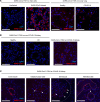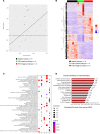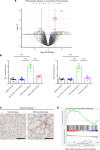A specific molecular signature in SARS-CoV-2-infected kidney biopsies
- PMID: 36749641
- PMCID: PMC10077488
- DOI: 10.1172/jci.insight.165192
A specific molecular signature in SARS-CoV-2-infected kidney biopsies
Abstract
Acute kidney injury is one of the most important complications in patients with COVID-19 and is considered a negative prognostic factor with respect to patient survival. The occurrence of direct infection of the kidney by SARS-CoV-2, and its contribution to the renal deterioration process, remain controversial issues. By studying 32 renal biopsies from patients with COVID-19, we verified that the major pathological feature of COVID-19 is acute tubular injury (ATI). Using single-molecule fluorescence in situ hybridization, we showed that SARS-CoV-2 infected living renal cells and that infection, which paralleled renal angiotensin-converting enzyme 2 expression levels, was associated with increased death. Mechanistically, a transcriptomic analysis uncovered specific molecular signatures in SARS-CoV-2-infected kidneys as compared with healthy kidneys and non-COVID-19 ATI kidneys. On the other hand, we demonstrated that SARS-CoV-2 and hantavirus, 2 RNA viruses, activated different genetic networks despite triggering the same pathological lesions. Finally, we identified X-linked inhibitor of apoptosis-associated factor 1 as a critical target of SARS-CoV-2 infection. In conclusion, this study demonstrated that SARS-CoV-2 can directly infect living renal cells and identified specific druggable molecular targets that can potentially aid in the design of novel therapeutic strategies to preserve renal function in patients with COVID-19.
Keywords: Apoptosis; COVID-19; Molecular pathology; Nephrology.
Figures





References
Publication types
MeSH terms
LinkOut - more resources
Full Text Sources
Medical
Molecular Biology Databases
Miscellaneous

